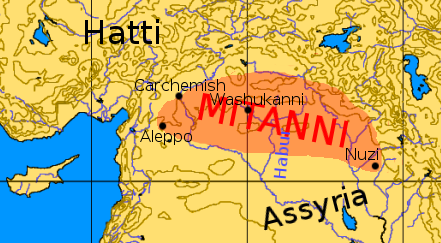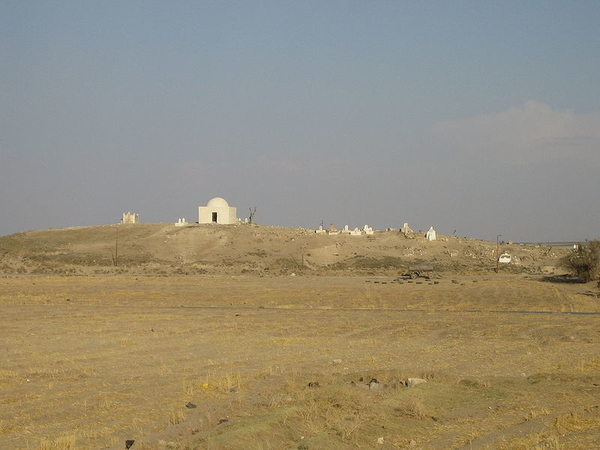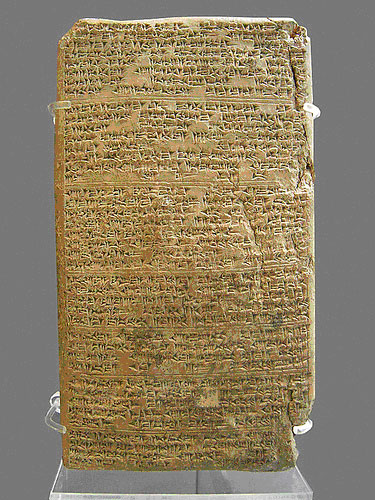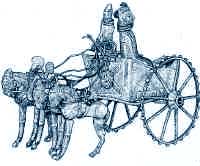
| MITANNI Location :
Mitanni Lands. Source: Wikipedia The kingdom of the Mitanni Indo-Iranian dynasty that ruled in the land of the Hurrians was located in the upper Euphrates-Tigris basin - land that is now part of northern Iraq, Syria and south-eastern Turkey.
At its greatest extent (for a brief period at the height of its dynastic power), Mitanni territory extended to the Mediterranean coast and into northern Assyria / Mesopotamia, it's south-eastern neighbour.
Mitanni's north-western border with the Hattian kingdom of the Hittites was fluid and constantly subject to aggression except when the two rivals concluded a peace treaty - one that invoked the Indo-Iranian pantheon of Mitra, Varuna, Indra and the Nasatyas - but also one that marked the decline of the Mitanni kingdom and a decrease in size. The Mitanni and Hittites were closely related. The Hittites used the Hurrian language extensively in their inscriptions. They also shared in the development of the light chariot whose wheels used spokes.
The Hurrian lands are today a part of Greater Kurdistan.
Wassukanni / Washukanni - Mitanni Capital :
Reputed location of the Mitanni capital, Washukanni: Tell Fecheriye, Syria. Source: Wikipedia The Mitanni capital was Wassukanni / Washukanni and its location has been determined by archaeologists to be on the headwaters of the River Habur, a tributary of the Euphrates.
The name Washukanni is similar to the Kurdish word bashkani, bash meaning good and kanî meaning well or source (Kurdish has the same name, kani, for well and source). The Luwian word vasu also means good. The name is similar to the Sanskrit word vasukhani meaning 'mine of wealth'.
Some believe the ancient city of Sikan was built on the site of Washukanni, and that its ruins may be located under the mound of Tell Fecheriye/el Fakhariya near Gozan in Syria. Other proposed locations for Wassukanni are Rais el Ain in Syria (80 km. east of Akcakale, Turkey), and further north near Diyarbakir (ancient Amida), a Kurdish city and province.
The Mitanni Dynasty :
Tushratta's letter to Amenhotep III of Egypt. British Museum WAA 29791 For a period, the extent of Mitanni control included parts of northern Assyria, including the Nineveh and Ashur. However, after the mid-fourteenth century BCE, Mitanni was plagued by a dynastic crisis and palace intrigue. It appears that the young king Tusratta who had been installed as a figure-head after the murder of his father, was not universally recognized and as a result, he lost control of the Assyrian lands at the outset of his reign. At the same time, in northeast Mitanni, a rival named Artatama II seems to have created a kingdom of his own and the Hittites invaded Mitanni - an attack that Tusratta managed to repulse.
Despite Tusratta's problems, he was not beyond offering his daughter Tadukhipa in marriage to the King Amenhotep III of Egypt for a large quantity of gold. The tablet seen to the right is a letter from Tusratta to Amenhotep in which he asks for "gold in very great quantity" as a bride price, supporting his request with the comment, "Gold is as dust in the land of my brother."
The beleaguered Tusratta was then murdered by his son in a palace coup. Tusratta's other son, Prince Shattiwaza, fled Mitanni and was eventually given sanctuary by the Hittite King Suppiluliuma with whom he concluded a treaty c. 1380 BCE, which we know as the Suppiluliuma-Shattiwaza Treaty (discovered in 1907 CE in Hattusa, near present-day Bogazkale (Bogazkale, formerly Bogazköy) in north-central Turkey. In the treaty, the Hittite King Suppiluliuma agreed to assist Shattiwaza gain the Mitanni throne and invaded Mitanni. The Hittites captured the Mitanni capital Wassukanni after a second attempt and installed Shattiwaza as a vassal king.
The Suppiluliuma-Shattiwaza Treaty is a source of considerable information about the Mitanni. In addition, it gives us some astonishing information about the religious practices of the Mitanni for it invokes the Indo-Iranian pantheon of asuras and devas Mitras (il) (Mitra), Uruvanass (il) (Varuna), Indara (Indra) and the Nasatianna (Nasatyas) (Ashwins).
Following the capture of Wassukanni, the Hittites installed new rulers in Mitanni towns while the Assyrians regained control of the territory they had lost to the Mitanni. Tusratta was killed and his son Shattiwaza became a vassal of the Hittite Suppiluliuma (c.1344 - 1322 BCE). At the same time, the rebellious Artatama became a puppet king of a reborn Assyria, led by king Assur-Uballit I (1364-1328 BCE). Wassukanni was sacked again by the Assyrian king Adad-Nirari I around 1290 BCE, after which very little is known of its history.
In our page on the Hittites, we note :
"In the Bogazkale archives, native Hurrian is used frequently for a wide range of non-official texts such as those on rituals and even the Epic of Gilgamesh - more so than native Hattian. Native Hurrian texts have been found throughout the region. One such text dated to 1750 BCE was found at Tell Hariri (ancient Mari), a Middle Euphrates site, and another at Ras Shamra (Ugarit) on the Syrian coast indicating Hurrian i.e. Mitanni influence in the region preceded the rise of Hittite power. A similar language to Hurrian is the language of Urartu located to the east of the Hittite lands at the headwaters of the Euphrates and around Lake Van. According to the literature (cf. The Hittites by O. R. Gurney, Penguin Books 1981), The Hurrians were migrants to the Upper Euphrates and Habur basin from the Elburz Mountains east across the Taurus Mountains from about 2300 BCE onwards."
Famed Charioteers :
Mitanni Chariot note wheels with spokes The Mitanni were famed charioteers. They are reported to have spearheaded the development of the light war chariot with wheels that used spokes rather than solid wood wheels like those used by the Sumerians.
The Mitanni name for chariot warriors was maryanna or marijannina, a form of the Indo-Iranian term marya meaning 'young man," used in the Rig Ved when referring to the celestial warriors assembled around the Vedic deity Indra.
Expertise in Horse Training :
A Hurrian text from Yorgan Tepe also uses Indo-Iranian words to describe the colour of horses, words such as babru for brown, parita for grey, and pinkara for a reddish hue.
The Kikkuli manual for training chariot horses highlights the links between the Mitanni and Hittites. Even though they were rivals at times, the two groups also collaborated frequently. The fact that the Hittites employed a Mitanni as a master trainer of horses may indicate that it was the Mitanni who were the regional experts in horse training especially for military purposes (in a manner similar to the Sogdians in the East) and that the Mitanni in turn had brought the expertise with them in their migration westward.
The methods used in the Kikkuli method enabled horses to be trained without injury. The text detailed a 214-day training regime using interval training and sports medicine techniques such as the principle of progression, peak loading systems, electrolyte replacement, fartlek training, intervals and repetitions and was directed at horses with a high proportion of slow-twitch muscle fibres. the Kikkuli horses were stabled, rugged, washed down with warm water and fed oats, barley and hay at least three times per day.
Kikkuli's interval training technique stressed the leading of horses at a trot, canter and gallop, before subjecting them to the weight bearing stress of a rider, driver or chariot. Workouts sometimes numbered three a day with scheduled rest days. Kikkuli's interval training contained three stages - the first two for developing strong legs and a strong cardio-muscular system, and the third for increasing neuromuscular conditioning. His workouts included brief recoveries to lower the heart rate. Swimming was also included in intervals of three to five sessions, with rest periods after each session. The horses were also subject to warming down periods and the method's example of cantering included intermediate pauses to lower the heart rate partially and as the training advanced the workouts included intervals at the canter.
Mitanni Indo-Iranian Names :
The names of proto-Indo-Iranian dieties are also found to form the names of the Kassite rulers of Babylonia.
Arta :
Philologists trace the Mitanni names to the Vedic equivalents. For instance, they note that the royal name Artatama was a form of the Indo-Iranian R'ta-dhaanman meaning 'the abode of rta', and the name Artas's'umara was a form of Rta-smara meaning 'remembering r'ta'.
However, for some reason, none of the writers that we have come across link the name to their Old Iranian or Old Persian equivalents - equivalents that will be closer to the Mitanni names as we have demonstrated with the use of arta above.
Society Structure & Rule of Law :
Land Conveyance :
Agriculture & Manufacturing :
Records indicate that sheep were bred for their wool on which an extensive woollen and textile industry was based. The manufactured textiles were collected by the palace were exported on a large scale.
According to the Metropolitan Museum of Art, "glass was produced on a large scale for the first time around 1600 BCE, perhaps in the Mitanni state of northern Mesopotamia."
Trade :
Source :
http://www.heritageinstitute.com/ |



